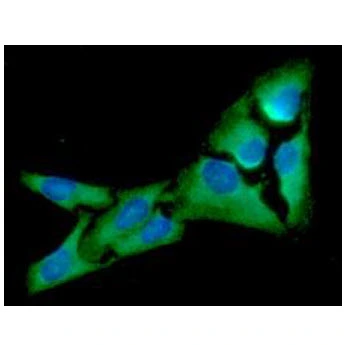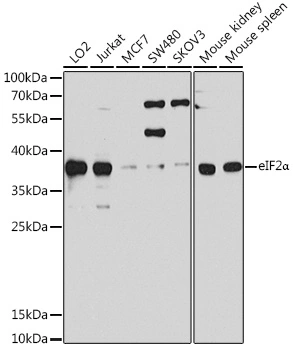eIF2 alpha antibody
GTX112919
ApplicationsWestern Blot
Product group Antibodies
TargetEIF2S1
Overview
- SupplierGeneTex
- Product NameeIF2 alpha antibody
- Delivery Days Customer9
- ApplicationsWestern Blot
- CertificationResearch Use Only
- ClonalityPolyclonal
- Concentration0.4 mg/ml
- ConjugateUnconjugated
- Gene ID1965
- Target nameEIF2S1
- Target descriptioneukaryotic translation initiation factor 2 subunit alpha
- Target synonymsEIF-2, EIF-2A, EIF-2alpha, EIF2, EIF2A, eukaryotic translation initiation factor 2 subunit 1, eIF-2-alpha, eIF2-alpha, eukaryotic translation initiation factor 2, subunit 1 alpha, 35kDa
- HostRabbit
- IsotypeIgG
- Protein IDP05198
- Protein NameEukaryotic translation initiation factor 2 subunit 1
- Scientific DescriptionThe translation initiation factor eIF2 catalyzes the first regulated step of protein synthesis initiation, promoting the binding of the initiator tRNA to 40S ribosomal subunits. Binding occurs as a ternary complex of methionyl-tRNA, eIF2, and GTP. eIF2 is composed of 3 nonidentical subunits, alpha (36 kD), beta (38 kD, MIM 603908), and gamma (52 kD, MIM 300161). The rate of formation of the ternary complex is modulated by the phosphorylation state of eIF2-alpha (Ernst et al., 1987 [PubMed 2948954]).[supplied by OMIM]
- Storage Instruction-20°C or -80°C,2°C to 8°C
- UNSPSC12352203
References
- 6-Shogaol induces cell cycle arrest and apoptosis in human hepatoma cells through pleiotropic mechanisms. Wu JJ et al., 2015 Sep 5, Eur J PharmacolRead more
- Luteolin modulates 6-hydroxydopamine-induced transcriptional changes of stress response pathways in PC12 cells. Hu LW et al., 2014, PLoS OneRead more
- Arsenic trioxide induces unfolded protein response in vascular endothelial cells. Weng CY et al., 2014 Feb, Arch ToxicolRead more

![Rabbit anti EIF2alpha [pS51] phosphospecific polyclonal antibody. Left: Image shows immunocytochemical analysis of EIF2alpha [pS51] in rat brain (mediodorsal neocortex) sections following traumatic axonal injury (TAI) (24 h). Control (prior to injury induction) shows low basal levels of EIF2alpha [pS51]. Right: Image shows double labeling of APP (red) and EIF2alpha [pS51] (green) in neurons subjected to traumatic axonal injury (TAI). Inset (above): higher magnification of neuronal soma with TAI. EIF2alpha [pS51] immunofluorescence is localized in cytoplasm of neuronal cell body.](https://www.genetex.com/upload/website/prouct_img/normal/GTX24837/EIF2A-phospho-Ser52-antibody_ICCIF_GTX24837-1_w_23060722_500.webp)
![IHC-P analysis of human colon carcinoma tissue using GTX25369 eIF2 alpha antibody [EIF2a]. Right : Primary antibody Left : Negative control without primary antibody Antigen retrieval : 10mM sodium citrate (pH 6.0), microwaved for 8-15 min Dilution : 1:20](https://www.genetex.com/upload/website/prouct_img/normal/GTX25369/GTX25369_1277_IHC-P_w_23060722_469.webp)

![WB analysis of HeLa cell extracts with/without Calyculin A (100 nM, 37oC, 30 min) treatment after serum-starvation overnight or TNF-alpha (20 ng/ml, 37oC, 30 min) treatment using GTX00965 eIF2 alpha (phospho Ser51) antibody [GT1203]. Dilution : 1:1000 Loading : 25microg](https://www.genetex.com/upload/website/prouct_img/normal/GTX00965/GTX00965_20200327_WB_1_w_23053121_538.webp)
![WB analysis of HEK293T cells transfected with eIF2 alpha plasmid (Right) or empty vector (Left) for 48 hrs using GTX84578 eIF2 alpha antibody [3H7]. Loading : 5 ug per lane](https://www.genetex.com/upload/website/prouct_img/normal/GTX84578/GTX84578_4475_WB_w_23061420_557.webp)
![ICC/IF analysis of COS7 cells transiently transfected with eIF2 alpha plasmid using GTX84579 eIF2 alpha antibody [3H4].](https://www.genetex.com/upload/website/prouct_img/normal/GTX84579/GTX84579_1138_ICCIF_w_23061420_818.webp)
![IHC-P analysis of human prostate tissue using GTX84582 eIF2 alpha antibody [1H1]. Antigen retrieval : Heat-induced epitope retrieval by 10mM citrate buffer, pH6.0, 100oC for 10min.](https://www.genetex.com/upload/website/prouct_img/normal/GTX84582/GTX84582_2894_IHC-P_w_23061420_871.webp)

